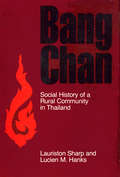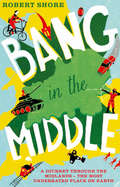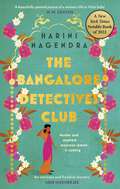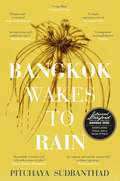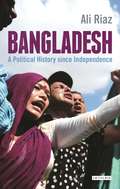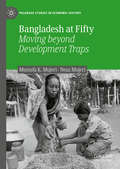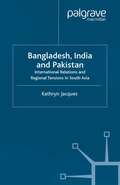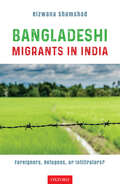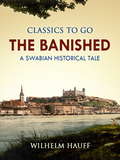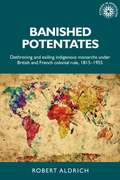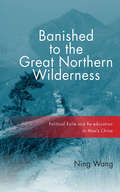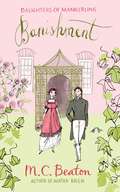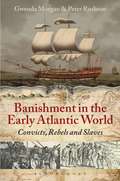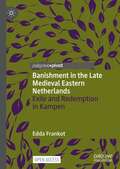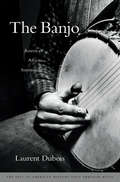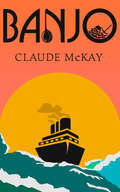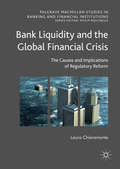- Table View
- List View
Bang Chan: Social History of a Rural Community in Thailand (Cornell Studies in Anthropology)
by Lauriston Sharp Lucien M. HanksBang Chan traces the changing cultural characteristics of a small Siamese village during the century and a quarter from its founding as a wilderness settlement outside Bangkok to its absorption into the urban spread of the Thai capital. Rich in ethnographic detail, the book sums up the major findings of a pioneering interdisciplinary research project that began in 1948. Changes in Bang Chan's social organization, technology, economy, governance, education, and religion are portrayed in the context of local and national developments.
The Bangalore Detectives Club (The Bangalore Detectives Club Series)
by Harini Nagendra'The first in an effervescent new mystery series. . . a treat for historical mystery lovers looking for a new series to savor (or devour)' NEW YORK TIMESMurder and mayhem . . . monsoon season is coming. _____________________________ Solving crimes isn't easy. Add a jealous mother-in-law and having to wear a flowing sari into the mix, and you've got a problem. When clever, headstrong Kaveri moves to Bangalore to marry doctor Ramu, she's resigned herself to a quiet life. But that all changes the night of the party at the Century Club, where she escapes to the garden for some peace - and instead spots an uninvited guest in the shadows. Half an hour later, the party turns into a murder scene. When a vulnerable woman is connected to the crime, Kaveri becomes determined to save her and launches a private investigation to find the killer, tracing his steps from an illustrious brothel to an Englishman's mansion. She soon finds that sleuthing in a sari isn't as hard as it seems when you have a talent for maths, a head for logic and a doctor for a husband. And she's going to need them all as the case leads her deeper into a hotbed of danger, sedition and intrigue in Bangalore's darkest alleyways . . . BOOK ONE IN THE BANGALORE DETECTIVES CLUB SERIES INCLUDES A BONUS CHAPTER OF DELICIOUS INDIAN RECIPES ___________ 'A gorgeous debut mystery with a charming and fearless sleuth . . . spellbinding' SUJATA MASSEY 'Told with real warmth and wit. . . A perfect read for fans of Alexander McCall Smith and Vaseem Khan' ABIR MUKHERJEE 'A cosy mystery that warmly illuminates a time and place not often examined in fiction' VASEEM KHAN 'A beautifully painted picture of a woman's life in 1920s India' M W CRAVEN 'A delight' CATRIONA MCPHERSON 'The classic whodunnit with the added appeal of a female sleuth in Colonial India. . . fascinating' RHYS BOWEN 'Told with real warmth and wit. . . Nagendra has created an intricate and fiendish mystery... A perfect read for fans of Alexander McCall Smith and Vaseem Khan' - ABIR MUKHERJEE 'Riveting. [Nagendra's] use of colonial history is thoroughly fascinating, with devastating depictions of the airy condescension of the British. A fine start to a promising series' BOOKLIST Starred Review 'Harini Nagendra takes us to a wonderfully unfamiliar world in this delightful debut mystery. . .I couldn't put it down' VICTORIA THOMPSON'Absolutely charming . . . this one is a winner!' CONNIE BERRY'An enjoyable trip back in time with a spunky young woman for company.' R V RAMAN'Mouth-watering fashion and food set against simmering colonial intrigue in this delicious whodunit can be devoured in one sitting.' SUMI HAHN'I loved The Bangalore Detectives Club . . . Kaveri especially is charming.' OVIDIA YU'Nagendra makes her fiction debut with an exceptional series launch. . . rich, edifying, and authentic' Publishers Weekly, Starred Review 'Deliciously exotic' Sunday Post
Bangkok Wakes to Rain: A Novel
by Pitchaya SudbanthadPlaces remember us... 'An important, ambitious, and accomplished novel. Sudbanthad deftly sweeps us up in a tale that paints a twin portrait: of a megacity like those so many of us call home and of a world where sanctuary is increasingly hard to come by' Mohsin HamidIn the restless city of Bangkok, there is a house.Over the last two centuries, it has played host to longings and losses past, present, and future, and has witnessed lives shaped by upheaval, memory and the lure of home.A nineteenth-century missionary pines for the comforts of New England, even as he finds the vibrant foreign chaos of Siam increasingly difficult to resist. A jazz pianist is summoned in the 1970s to conjure music that will pacify resident spirits, even as he's haunted by ghosts of his former life. A young woman in a time much like our own gives swimming lessons in the luxury condos that have eclipsed the old house, trying to outpace the long shadow of her political past. And in the submerged Bangkok of the future, a band of savvy teenagers guides tourists and former residents past waterlogged landmarks, selling them tissues to wipe their tears for places they themselves do not remember.Time collapses as their stories collide and converge, linked by blood, memory, yearning, chance, and the forces voraciously making and remaking the amphibian, ever-morphing city itself.Praise for Bangkok Wakes to Rain:'Beautifully textured and rich with a sense of place . . . compellingly captures not only the long arcs of these lives - but also the smallest moments, and how those moments linger in memory, how they haunt.' Karen Thompson Walker, author of The Age of Miracles 'A bold and tender novel about the unforgivable and the unforgiven, and how to live past what you thought you could not survive. Sudbanthad arrives to us already a masterful innovator of the form.' Alexander Chee, author of The Queen of the Night 'Moves with an elegant restlessness that seems to match the city's own. Reading this book feels like waking to a singular and important new voice.' Rajesh Parameswaran, author of I Am An Executioner
Bangladesh: A Political History since Independence (International Library of Twentieth Century History)
by Ali RiazBangladesh is a country of paradoxes. The eighth most populous country of the world, it has attracted considerable attention often for the wrong reasons: corruption, natural disasters caused by its precarious geographical location, and volatile political situations with several military coups, following independence. Yet the country has demonstrated significant economic potential and has achieved successes in areas such as female education, population control and reductions in child mortality. Ali Riaz here examines the political processes which engendered these paradoxical tendencies. This comprehensive and unique overview of political and historical developments in Bangladesh since 1971 will provide essential reading for observers of Bangladesh and South Asia.
Bangladesh at Fifty: Moving beyond Development Traps (Palgrave Studies in Economic History)
by Mustafa K. Mujeri Neaz MujeriThis book explores the diverse experience of Bangladesh’s development over the last fifty years and provides systematic explanations of its success in socioeconomic development. It also assesses future trends on the basis of past experiences. It is widely acknowledged that Bangladesh provides one of the most striking examples in the study of present day development along with rapid growth and catching up. The analysis highlights the development traps that Bangladesh faced during its journey and the ones that may have to be faced in the coming decades in order to move towards prosperity. The book asserts that explaining Bangladesh’s development is not for the simpleminded; any single mono-causal explanation for Bangladesh’s development is bound to fall down in the face of reality. This book will be of interest to academics, students, policy makers and development practitioners especially in developing countries—in particular in South Asia and Bangladesh.
Bangladesh, India & Pakistan: International Relations and Regional Tensions in South Asia (International Political Economy Series)
by K. JacquesThis book provides a broad, analytical study of Bangladesh's relationship with India and Pakistan between 1975 and 1990. Bangladesh's role in South Asian international relations has tended to be overlooked and underestimated. The book reveals the complexity of the relationship between Bangladesh, India and Pakistan.
Bangladeshi Migrants in India: Foreigners, Refugees, or Infiltrators?
by Rizwana ShamshadIn January 2011, Felani Khatun was shot dead while attempting to cross the border from India to Bangladesh. Her body remained hung on the fence as a warning to those who illegally crossed an international border. Migration to India from the current geographical and political entity called Bangladesh is more than a century old and had begun long before the nation states were created in South Asia. Often termed as ‘foreigners’ and ‘infiltrators’, Bangladeshi migrants such as Felani find their way into India for the promise of a better future. Post 1971, there has been a steady movement of people from Bangladesh into India, both as refugees and for economic need, making this migration a complex area of inquiry. This book focuses on the contemporary issue of undocumented Bangladeshi migration to the three Indian states of Assam, West Bengal, and Delhi, and how the migrants are perceived in light of the ongoing discourses on the various nationalisms in India. Each state has a unique history and has taken different measures to respond to Bangladeshi migrants present in the state. Based on extensive fieldwork and insightful interviews with influential members from key political parties, civil society organizations, and Hindu and ethnic nationalist bodies in these states, the book explores the place and role of Bangladeshi migrants in relation to the inherent tension of Indian nationalism.
The Banished: A Swabian Historical Tale, Volume 3 (Classics To Go)
by Wilhelm HauffExcerpt: "The events which are recorded in the following pages, took place in that part of Southern Germany situated between the mountainous district of the Alb and the Black Forest. That portion of territory is bounded by the former on the north-west, by a long chain of hills of unequal height and breadth, extending southward, whilst the forest, commencing from the sources of the Danube, stretches uninterruptedly to the banks of the Rhine. Being composed of woods of black pine, it forms a dark background to the beautiful picture produced by a luxuriant country,rich in vineyards and watered by the Neckar, which flows through it.
Banished potentates: Dethroning and exiling indigenous monarchs under British and French colonial rule, 1815–1955 (Studies In Imperialism Ser.)
by Robert AldrichAn examination of British and French deposition and exile of indigenous monarchs in Asia and Africa from 1815 until the 1950s.
Banished potentates: Dethroning and exiling indigenous monarchs under British and French colonial rule, 1815–1955 (Studies in Imperialism #154)
by Robert AldrichThough the overthrow and exile of Napoleon in 1815 is a familiar episode in modern history, it is not well known that just a few months later, British colonisers toppled and banished the last king in Ceylon. Beginning with that case, this volume examines the deposition and exile of indigenous monarchs by the British and French – with examples in India, Burma, Malaysia, Vietnam, Madagascar, Tunisia and Morocco – from the early nineteenth century down to the eve of decolonisation. It argues that removal of native sovereigns, and sometimes abolition of dynasties, provided a powerful strategy used by colonisers, though European overlords were seldom capable of quelling resistance in the conquered countries, or of effacing the memory of local monarchies and the legacies they left behind.
Banished potentates: Dethroning and exiling indigenous monarchs under British and French colonial rule, 1815–1955 (Studies In Imperialism Ser. #154)
by Robert AldrichThough the overthrow and exile of Napoleon in 1815 is a familiar episode in modern history, it is not well known that just a few months later, British colonisers toppled and banished the last king in Ceylon. Beginning with that case, this volume examines the deposition and exile of indigenous monarchs by the British and French – with examples in India, Burma, Malaysia, Vietnam, Madagascar, Tunisia and Morocco – from the early nineteenth century down to the eve of decolonisation. It argues that removal of native sovereigns, and sometimes abolition of dynasties, provided a powerful strategy used by colonisers, though European overlords were seldom capable of quelling resistance in the conquered countries, or of effacing the memory of local monarchies and the legacies they left behind.
Banished to the Great Northern Wilderness: Political Exile and Re-education in Mao’s China
by Ning WangAfter Mao Zedong’s Anti-Rightist Campaign of 1957–58, Chinese intellectuals were subjected to "re-education" by the state. In Banished to the Great Northern Wilderness, Ning Wang draws on labor farm archives, interviews, and memoirs to provide a remarkable look at the suffering and complex psychological world of these banished Beijing intellectuals. Wang’s use of newly uncovered Chinese-language sources challenges the concept of the intellectual as renegade martyr, showing how exiles often declared allegiance to the state for self-preservation. While Mao’s campaign victimized the banished, many of those same people also turned against their comrades. Wang describes the ways in which the state sought to remold the intellectuals, and he illuminates the strategies the exiles used to deal with camp officials and improve their chances of survival.
Banishment: A Novel Of Regency England - Being The First Volume Of The Daughters Of Mannerling (The Daughters of Mannerling Series #1)
by M.C. BeatonIsabella Beverley is blessed with unparalleled beauty but, unfortunately, has been raised in the most snobbish and haughty of families. And when her father gambles away their fortune - including Mannerling, the exquisite family mansion, Isabella discovers that there is very little sympathy for her plight. As the eldest, Isabella is chosen to court Mr. Judd, the roguish bachelor who won Mannerling. Surely no sacrifice is too great to regain Mannerling? But tempting her away from Mr. Judd is Lord Fitzpatrick, an Irish rake who fears Isabella can never love a man as she does her home - but is nonetheless determined to convince her to choose man over manse!
Banishment in the Early Atlantic World: Convicts, Rebels and Slaves
by Peter Rushton Gwenda MorganBanishing troublesome and deviant people from society was common in the early modern period. Many European countries removed their paupers, convicted criminals, rebels and religious dissidents to remote communities or to their colonies where they could be simultaneously punished and, perhaps, contained and reformed. Under British rule, poor Irish, Scottish Jacobites, English criminals, Quakers, gypsies, Native Americans, the Acadian French in Canada, rebellious African slaves, or vulnerable minorities like the Jews of St. Eustatius, were among those expelled and banished to another place. This book explores the legal and political development of this forced migration, focusing on the British Atlantic world between 1600 and 1800. The territories under British rule were not uniform in their policies, and not all practices were driven by instructions from London, or based on a clear legal framework. Using case studies of legal and political strategies from the Atlantic world, and drawing on accounts of collective experiences and individual narratives, the authors explore why victims were chosen for banishment, how they were transported and the impact on their lives. The different contexts of such banishment – internal colonialism ethnic and religious prejudice, suppression of religious or political dissent, or the savageries of war in Europe or the colonies – are examined to establish to what extent displacement, exile and removal were fundamental to the early British Empire.
Banishment in the Early Atlantic World: Convicts, Rebels and Slaves
by Peter Rushton Gwenda MorganBanishing troublesome and deviant people from society was common in the early modern period. Many European countries removed their paupers, convicted criminals, rebels and religious dissidents to remote communities or to their colonies where they could be simultaneously punished and, perhaps, contained and reformed. Under British rule, poor Irish, Scottish Jacobites, English criminals, Quakers, gypsies, Native Americans, the Acadian French in Canada, rebellious African slaves, or vulnerable minorities like the Jews of St. Eustatius, were among those expelled and banished to another place. This book explores the legal and political development of this forced migration, focusing on the British Atlantic world between 1600 and 1800. The territories under British rule were not uniform in their policies, and not all practices were driven by instructions from London, or based on a clear legal framework. Using case studies of legal and political strategies from the Atlantic world, and drawing on accounts of collective experiences and individual narratives, the authors explore why victims were chosen for banishment, how they were transported and the impact on their lives. The different contexts of such banishment – internal colonialism ethnic and religious prejudice, suppression of religious or political dissent, or the savageries of war in Europe or the colonies – are examined to establish to what extent displacement, exile and removal were fundamental to the early British Empire.
Banishment in the Late Medieval Eastern Netherlands: Exile and Redemption in Kampen
by Edda FrankotThis open access book analyses the practice of banishment and what it can tell us about the values of late medieval society concerning morally acceptable behaviour. It focuses on the Dutch town of Kampen and considers the exclusion of offenders through banishment and the redemption of individuals after their exile. Banishment was a common punishment in late medieval Europe, especially for sexual offences. In Kampen it was also meted out as a consequence of the non-payment of fines, after which people could arrange repayment schemes which allowed them to return. The books firstly considers the legal context of the practice of banishment, before discussing punishment in Kampen more generally. In the third chapter the legal practice of banishment as a punitive and coercive measure is discussed. The final chapter focuses on the redemption of exiles, either because their punishment was completed, or because they arranged for the payment of outstanding fines.
Banister Fletcher's A History Of Architecture (Part 1 of 7) (PDF)
by Banister Fletcher Dan Cruickshank Peter Blundell Jones Kenneth Frampton Andrew SaintThe 20th edition of Sir Banister Fletcher's A History of Architecture is the first major work of history to include an overview of the architectural achievements of the 20th Century. Banister Fletcher has been the standard one volume architectural history for over 100 years and continues to give a concise and factual account of world architecture from the earliest times. In this twentieth and centenary edition, edited by Dan Cruickshank with three consultant editors and fourteen new contributors, chapters have been recast and expanded and a third of the text is new. * There are new chapters on the twentieth-century architecture of the Middle East (including Israel), South-east Asia, Hong Kong, Japan and Korea, the Indian subcontinent, Russia and the Soviet Union, Eastern Europe and Latin America. * The chapter on traditional architecture of India has been rewritten and the section on traditional Chinese architecture has been expanded, both with new specially commissioned drawings * The architecture of the Americas before 1900 has been enlarged to include, for the first time, detailed coverage of Latin America and the Caribbean * The book's scope has been widened to include more architecture from outside Europe * The bibliography has been expanded into a separate section and is a key source of information on every period of world architecture * The coverage of the 20th century architecture of North America has been divided into two chapters to allow fuller coverage of contemporary works * 20th century architecture of Western Europe has been radically recast * For the first time the architecture of the twentieth century is considered as a whole and assessed in an historical perspective * Coverage has been extended to include buildings completed during the last ten years * The coverage of Islamic architecture has been increased and re-organised to form a self contained section This unique reference book places buildings in their social, cultural and historical settings to describe the main patterns of architectural development, from Prehistoric to the International Style. Again in the words of Sir Banister Fletcher, this book shows that 'Architecture . . . provides a key to the habits, thoughts and aspirations of the people, and without a knowledge of this art the history of any period lacks that human interest with which it should be invested. '
Banister Fletcher's A History Of Architecture (Part 2 of 7) (PDF)
by Banister Fletcher Dan Cruickshank Peter Blundell Jones Kenneth Frampton Andrew SaintThe 20th edition of Sir Banister Fletcher's A History of Architecture is the first major work of history to include an overview of the architectural achievements of the 20th Century. Banister Fletcher has been the standard one volume architectural history for over 100 years and continues to give a concise and factual account of world architecture from the earliest times. In this twentieth and centenary edition, edited by Dan Cruickshank with three consultant editors and fourteen new contributors, chapters have been recast and expanded and a third of the text is new. * There are new chapters on the twentieth-century architecture of the Middle East (including Israel), South-east Asia, Hong Kong, Japan and Korea, the Indian subcontinent, Russia and the Soviet Union, Eastern Europe and Latin America. * The chapter on traditional architecture of India has been rewritten and the section on traditional Chinese architecture has been expanded, both with new specially commissioned drawings * The architecture of the Americas before 1900 has been enlarged to include, for the first time, detailed coverage of Latin America and the Caribbean * The book's scope has been widened to include more architecture from outside Europe * The bibliography has been expanded into a separate section and is a key source of information on every period of world architecture * The coverage of the 20th century architecture of North America has been divided into two chapters to allow fuller coverage of contemporary works * 20th century architecture of Western Europe has been radically recast * For the first time the architecture of the twentieth century is considered as a whole and assessed in an historical perspective * Coverage has been extended to include buildings completed during the last ten years * The coverage of Islamic architecture has been increased and re-organised to form a self contained section This unique reference book places buildings in their social, cultural and historical settings to describe the main patterns of architectural development, from Prehistoric to the International Style. Again in the words of Sir Banister Fletcher, this book shows that 'Architecture . . . provides a key to the habits, thoughts and aspirations of the people, and without a knowledge of this art the history of any period lacks that human interest with which it should be invested. '
Banister Fletcher's A History Of Architecture (Part 3 of 7) (PDF)
by Banister Fletcher Dan Cruickshank Peter Blundell Jones Kenneth Frampton Andrew SaintThe 20th edition of Sir Banister Fletcher's A History of Architecture is the first major work of history to include an overview of the architectural achievements of the 20th Century. Banister Fletcher has been the standard one volume architectural history for over 100 years and continues to give a concise and factual account of world architecture from the earliest times. In this twentieth and centenary edition, edited by Dan Cruickshank with three consultant editors and fourteen new contributors, chapters have been recast and expanded and a third of the text is new. * There are new chapters on the twentieth-century architecture of the Middle East (including Israel), South-east Asia, Hong Kong, Japan and Korea, the Indian subcontinent, Russia and the Soviet Union, Eastern Europe and Latin America. * The chapter on traditional architecture of India has been rewritten and the section on traditional Chinese architecture has been expanded, both with new specially commissioned drawings * The architecture of the Americas before 1900 has been enlarged to include, for the first time, detailed coverage of Latin America and the Caribbean * The book's scope has been widened to include more architecture from outside Europe * The bibliography has been expanded into a separate section and is a key source of information on every period of world architecture * The coverage of the 20th century architecture of North America has been divided into two chapters to allow fuller coverage of contemporary works * 20th century architecture of Western Europe has been radically recast * For the first time the architecture of the twentieth century is considered as a whole and assessed in an historical perspective * Coverage has been extended to include buildings completed during the last ten years * The coverage of Islamic architecture has been increased and re-organised to form a self contained section This unique reference book places buildings in their social, cultural and historical settings to describe the main patterns of architectural development, from Prehistoric to the International Style. Again in the words of Sir Banister Fletcher, this book shows that 'Architecture . . . provides a key to the habits, thoughts and aspirations of the people, and without a knowledge of this art the history of any period lacks that human interest with which it should be invested. '
Banister Fletcher's A History Of Architecture (Part 4 of 7) (PDF)
by Banister Fletcher Dan Cruickshank Peter Blundell Jones Kenneth Frampton Andrew SaintThe 20th edition of Sir Banister Fletcher's A History of Architecture is the first major work of history to include an overview of the architectural achievements of the 20th Century. Banister Fletcher has been the standard one volume architectural history for over 100 years and continues to give a concise and factual account of world architecture from the earliest times. In this twentieth and centenary edition, edited by Dan Cruickshank with three consultant editors and fourteen new contributors, chapters have been recast and expanded and a third of the text is new. * There are new chapters on the twentieth-century architecture of the Middle East (including Israel), South-east Asia, Hong Kong, Japan and Korea, the Indian subcontinent, Russia and the Soviet Union, Eastern Europe and Latin America. * The chapter on traditional architecture of India has been rewritten and the section on traditional Chinese architecture has been expanded, both with new specially commissioned drawings * The architecture of the Americas before 1900 has been enlarged to include, for the first time, detailed coverage of Latin America and the Caribbean * The book's scope has been widened to include more architecture from outside Europe * The bibliography has been expanded into a separate section and is a key source of information on every period of world architecture * The coverage of the 20th century architecture of North America has been divided into two chapters to allow fuller coverage of contemporary works * 20th century architecture of Western Europe has been radically recast * For the first time the architecture of the twentieth century is considered as a whole and assessed in an historical perspective * Coverage has been extended to include buildings completed during the last ten years * The coverage of Islamic architecture has been increased and re-organised to form a self contained section This unique reference book places buildings in their social, cultural and historical settings to describe the main patterns of architectural development, from Prehistoric to the International Style. Again in the words of Sir Banister Fletcher, this book shows that 'Architecture . . . provides a key to the habits, thoughts and aspirations of the people, and without a knowledge of this art the history of any period lacks that human interest with which it should be invested. '
The Banjo: America's African Instrument
by Laurent DuboisAmerican slaves drew on memories of African musical traditions to construct instruments from carved-out gourds covered with animal skin. Providing a sense of rootedness, solidarity, and consolation, banjo picking became an essential part of black plantation life, and its unmistakable sound remains versatile and enduring today, Laurent Dubois shows.
Banjo: A Story Without a Plot
by Claude McKayLincoln Agrippa Daily, known to his drifter cohorts on the 1920s Marseille waterfront as Banjo, passes his days panhandling and dreaming of starting his own band. At night Banjo and his buddies prowl the rough waterfront bistros, drinking, looking for women, playing music, fighting, loving, and talking. When Ray, a writer, joins the group, it triggers Banjo's rediscovery of his African roots and his feeling that, at last, he belongs to a race weighted, tested and poised in the universal scheme.Penguin Random House Canada is proud to bring you classic works of literature in e-book form, with the highest quality production values. Find more today and rediscover books you never knew you loved.
Bank Liquidity and the Global Financial Crisis: The Causes and Implications of Regulatory Reform (Palgrave Macmillan Studies in Banking and Financial Institutions)
by Laura ChiaramonteOne of the lessons learned from the Global Financial Crisis of 2007–9 is that minimum capital requirements are a necessary but inadequate safeguard for the stability of an intermediary. Despite the high levels of capitalization of many banks before the crisis, they too experienced serious difficulties due to insufficient liquidity buffers. Thus, for the first time, after the GFC regulators realized that liquidity risk can jeopardize the orderly functioning of a bank and, in some cases, its survival. Previously, the risk did not receive the same attention by regulators at the international level as other types of risk including credit, market, and operational risks. The GFC promoted liquidity risk to a significant place in regulatory reform, introducing uniform international rules and best practices. The literature has studied the potential effects of the new liquidity rules on the behaviour of banks, the financial system, and the economy as a whole. This book provides a comprehensive understanding of the bank liquidity crisis that occurred during the GFC, of the liquidity regulatory reform introduced by the Basel Committee with the Basel III Accord, and its implications both at the micro and macroeconomic levels.
Bank Liquidity and the Global Financial Crisis: The Causes and Implications of Regulatory Reform (Palgrave Macmillan Studies in Banking and Financial Institutions)
by Laura ChiaramonteOne of the lessons learned from the Global Financial Crisis of 2007–9 is that minimum capital requirements are a necessary but inadequate safeguard for the stability of an intermediary. Despite the high levels of capitalization of many banks before the crisis, they too experienced serious difficulties due to insufficient liquidity buffers. Thus, for the first time, after the GFC regulators realized that liquidity risk can jeopardize the orderly functioning of a bank and, in some cases, its survival. Previously, the risk did not receive the same attention by regulators at the international level as other types of risk including credit, market, and operational risks. The GFC promoted liquidity risk to a significant place in regulatory reform, introducing uniform international rules and best practices. The literature has studied the potential effects of the new liquidity rules on the behaviour of banks, the financial system, and the economy as a whole. This book provides a comprehensive understanding of the bank liquidity crisis that occurred during the GFC, of the liquidity regulatory reform introduced by the Basel Committee with the Basel III Accord, and its implications both at the micro and macroeconomic levels.
